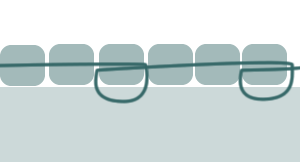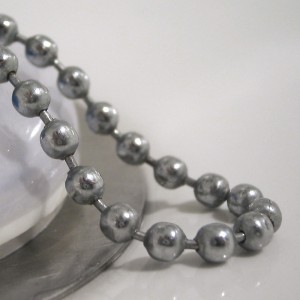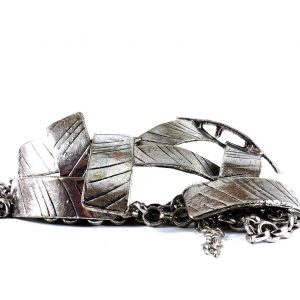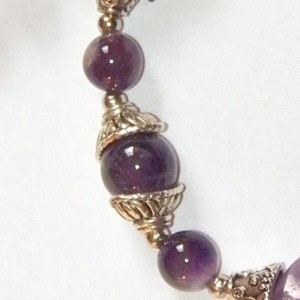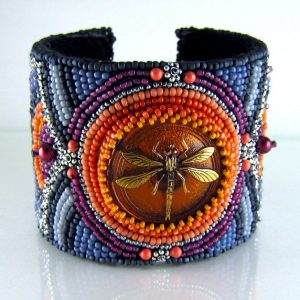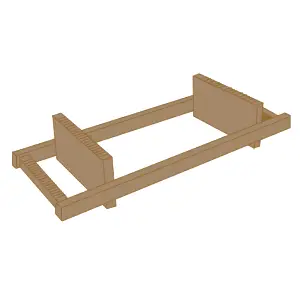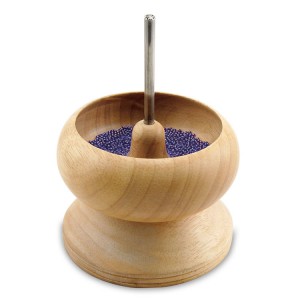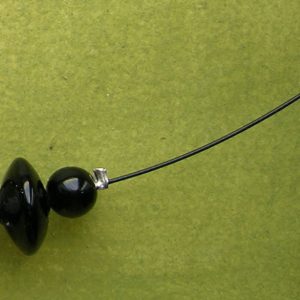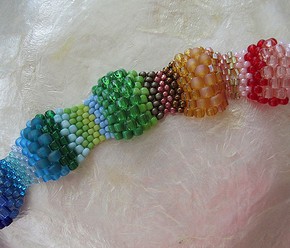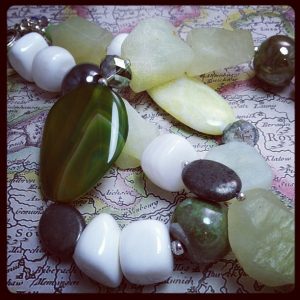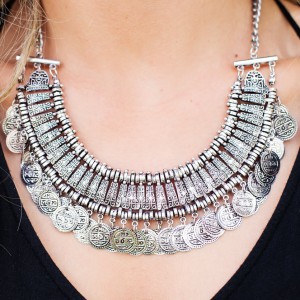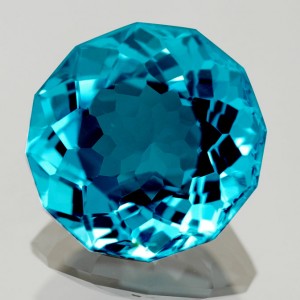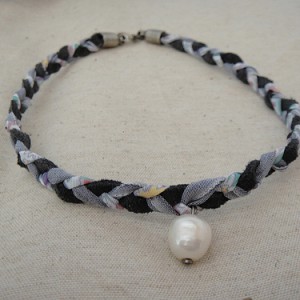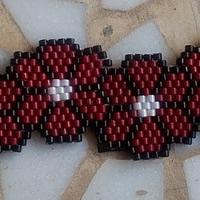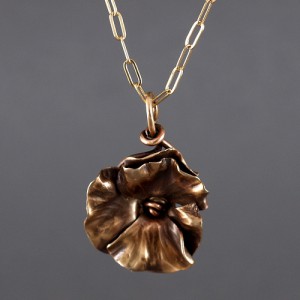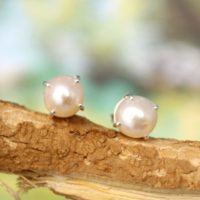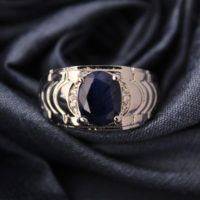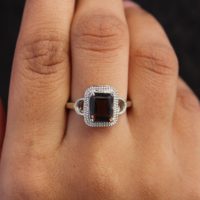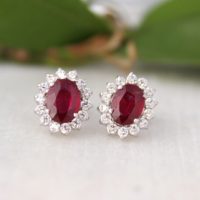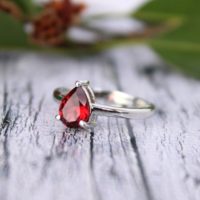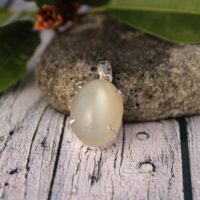Beading Glossary: Letter B
Backstitch
The running back stitch is a basic stitch often used to add beads to fabric. Both easy and durable, it can be used for a small embellishment or to cover an entire area with an elaborate design.
Bali beads
Originally, Bali beads referred to sterling silver beads made individually by hand in Bali, Indonesia. The style has since been mass produced and sold under the same moniker.
Ball Chain
Chain consisting of small metal spheres, often used in key chains or dog tag necklaces.
Bangle
A style of bracelet consisting of a closed ring, usually metal or plastic and often brightly colored. Popular in the 1980s.
Barrel Bead
Barrel refers to the shape of the bead – the bead can be made of any material such as metal, glass, wood, or plastic.
photo creditBarrel Clasp
A common form of clasp, especially for necklaces. Can be hard to attach on bracelets without help, and often comes undone on anklets, so is best suited for necklaces.
Base Metal
A common metal not considered to be precious. Examples include nickel, copper, aluminum, and zinc. Base metal findings tend to oxidize or corrode relatively easily in comparison with precious metals like silver and gold. They also produce more allergic reactions. Base metals are much cheaper than precious metals so they are best to use while designing, even if your final piece will be made with precious metals.
Bead Embroidery
Bead embroidery is technique for adding beads to fabric using traditional embroidery stitches. Beads can be used as embellishments on an incredible array of items from garments to shoes to home decor.
photo creditBead Loom
A bead loom is similar to a regular fabric loom, except with beads strung on the weft (the thread that passes over and under the warp threads). Typically one bead is positioned between each warp thread, and then the weft is threaded around the final warp and back through the beads to secure them in place. Loomwork is a beadweaving technique that uses a bead loom.
Bead Spinner
A bowl with a central spindle that makes it easier and faster to string strands of seed beads or liquid silver. A curved beading needle is placed in the beads in the bowl and threads them as you spin the bowl. Buy Spin-N-Bead
Beading cone
A metal cone finding that covers the ends of the strands in a multi-stranded necklace. The cone lets you attach a clasp, while concealing the knots that secure the ends of the strands.
Beading Wire
A thin wire or cable made from braiding several strands of thin steel wire together and then coating them with nylon. It is stiff so it does not require a needle to use. Brands of beading wire include Accu-flex, Beadalon, and Soft Flex. Beading wire is extremely strong and durable, although it is prone to kinking. Beading wire cannot be tied in a knot like thread, so jewelry must be finished using crimp beads.
Beadweaving
Creating jewelry using thread to weave patterns and objects with beads, usually seed beads. Weaving can be done on a loom to create a flat fabric-like sheet of beads, or “off-loom” using a needle and thread.
Beggar Beads
Large, irregular or baroque semi-precious beads, often consisting of varieties of agate and/or quartz. photo credit
Beryl
Beryl (beryllium aluminum cyclosilicate) is the name of a family of stones that includes Emerald, Bixbite, Aquamarine, Morganite, Goshenite, Golden Beryl, Heliodor, and Honey Yellow Beryl. It is found in a variety of colors and is quite durable (except emerald). Pure Beryl is colorless, but it is often tinted by impurities, giving you the gemstones listed above. Beryl is found in many parts of Europe, the United States, and other parts of the world.
Bib Necklace
A style of necklace that mimics a baby’s bib, with a thick section on the chest and a thin cord going around the back of the neck.
Bicone
A type of bead that looks like two pyramids or cones stuck together at their bases.
photo creditBirthstone
Birthstones are the tradition of assigning stones to each month of birth. The practice may trace back to Moses and the twelve tribes of Israel.
Bolo
A bolo tie can be made from a piece of cord, string, or braided leather fashioned into a necktie. It is fastened at the throat with decorative tips or an ornamental clasp. The two ends of the cord are threaded through the clasp so they are held in parallel, with the tips meeting each other evenly at the base. The clasp can be placed higher or lower in position on the chest, as the wearer prefers. photo credit
Bolt ring
Another name for a spring ring clasp.
Brass
An alloy of copper and zinc. Its malleability makes it easy to mold and it can also be worked “cold”. Brass wire give a distinctive color to pieces. Brass beads are sometimes plated with silver, gold or other precious metals. Different techniques are used to colorize brass beads including oxidation and polishing. The finest brass beads are imported from Africa or Asia.
Brick Stitch
A beadweaving stitch made with seed beads which looks like bricks stacked on top of each other. Often used in triangular fringed earrings. Looks somewhat like peyote stitch sideways, although they are made differently.
Bronze
An alloy of copper consisting of copper mixed with tin. The term “bronze” is also used to describe objects that are the color of bronze, which is a deep brown. photo credit
Bugle Beads
Bugle beads are thin tubular shaped glass beads manufactured in lengths from 2 millimeters to 35 millimeters and a width of 1-2 mm. Bugle beads can be threaded into jewelery or glued to fabric as decoration. These beads can be used to great effect in cascading style necklaces. Necklaces consisting purely of silver bugle beads are sometimes called liquid silver. photo credit
Bullion
Also known as French Wire or Gimp. This is a very finely coiled wire that forms a flexible tube like a spring. It is used for finishing the ends of strung jewelry pieces. It is threaded over the cord to cover it where it is normally exposed, such as where the cord goes through the loop on the clasp at the ends of the piece. It gives a professional look and protects the bead cord from fraying from exposure. The downside is that it tends to wear rather quickly itself, so it is good for fancy jewelry that you don’t wear often.
